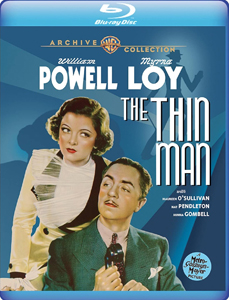“The Thin Man” movie adaptation (1934) is a fascinating case study in how some things work for the written word and some things work for the filmed scene. Although I love the dialog rhythms and intelligent clueing of Dashiell Hammett’s novel from earlier in 1934, I can’t quibble much with the changes in the quickly turned-around screenplay by Albert Hackett and Frances Goodrich.
Director W.S. Van Dyke takes this script – which includes a lot of Hammett’s one-liners but also great new ones – and rightly emphasizes husband and wife Nick and Nora Charles. William Powell and Myrna Loy are the textbook definition of chemistry, exchanging dialog like a singing duet.
He’s a confident, suave and clever ex-detective; she’s a beautiful, spunky and witty heir to a successful family business who is interested in learning about the sleuthing game. They don’t always banter; one of the nicest scenes finds them on Christmas morning, with Nick shooting a pop gun at balloons on the tree while Nora is bemused.

“The Thin Man” (1934)
Director: W.S. Van Dyke
Writers: Albert Hackett, Frances Goodrich (screenplay); Dashiell Hammett (novel)
Stars: William Powell, Myrna Loy, Maureen O’Sullivan
The Charleses translate smoothly from Hammett’s page, but there’s something about seeing them, not just reading about them. I’m excited that there are five more “Thin Man” movies to watch – even though it’s a weird title for the series, since the Thin Man is only in this first one.
Despite these excellent leads, I prefer the book. The characters pop more under Hammett’s hardboiled descriptions than via the performances (or at least equally, in the case of the leads).
Dotty Dorrie steps aside
The biggest loss from the book is Dorothy Wynant (Maureen O’Sullivan). She’s the 20-ish daughter of the title character, Clyde (Edward Ellis), who has gone missing and is perhaps committing a string of murders. (The New York tabloids certainly imagine he is.)
Dorothy is a wild child in the novel, its most memorable character, even given the spousal leads. In the film, O’Sullivan flattens her out, and she’s a background character in terms of screen time.
Moved to the foreground is Clyde, as Ellis portrays him in a long opening segment before we meet Nick and Nora. In the novel, he’s the absent center, gaining form because every character knows him in some way. For the film, Van Dyke decides we should get an unambiguous picture of the title character, and I can’t quibble.
Although key characters turn flatter, others characters come alive. I like Nat Pendleton’s Guild, a noir police detective with a touch of Bogart who begrudgingly yields the floor to both Nick’s faster verbal processes and sharper detection skills.
Minna Gombell plays Mimi – Clyde’s ex-wife who schemes in a secretive yet bumbling way — with appropriate scope. She makes me think of modern actress Lucy Davis. She’s an exception in a movie that might otherwise challenge modern viewers with face blindness, as women’s hairstyles and men’s suits are interchangeable among the cast (a common issue with old black-and-white movies).
Cinematic touches
Hammett’s plot is complex but graspable, and I doubt I could’ve followed along with the film (which has the same plot, but emphasizes different things) if I didn’t have the book fresh in my mind. Yet I can’t really blame Van Dyke, because he always goes with “show” in instances where Hammett uses “tell.” The book’s Nick often tells Nora or others what happened (based on his surmises, not hard facts, but his detection expertise serves him well).
“Show” turns to “showy” in a grand finale where Nick gathers every character – except for the murder victims, naturally – for a dinner party at their New York suite (where the San Francisco-based couple is vacationing). Agatha Christie’s Poirot would be proud.
Van Dyke also works in visual jokes. Nick pretends he’s about to smack Nora, but only for the sake of goofing with their audience, the Thin Man’s lawyer MacCaulay (Porter Hall). Later, the Charleses’ dog Asta accompanies Nick on a darkly lit sleuthing mission when an intruder comes upon them. “That dog will tear you to shreds,” Nick warns. Cut to the terrier cowering under a desk.
A talky early talkie
The leads are so good that they overcome sometimes slow pacing that doesn’t match with their ping-pong dialog. And although I’d call their exchanges lived-in and natural, sometimes their reactions are broad. Nick often gapes at mildly scandalous statements from Nora. I think his surprise is purposely exaggerated – part of their insider humor – but it’s jarring how the camera holds on him for an extra beat.
Both book and movie have an odd issue wherein the mystery feels like it’s in the background, even though it unspools before our eyes. In the book, it’s because of the strong presence of two self-involved teenagers — Dorothy and her brother, Gilbert (William Henry), whose weirdness is still present but toned down for the film.
In the film, the mystery is good, but Nick and Nora are great under the Hollywood spotlight. I’d rather watch them dance through more party scenes than have Nick return to professional sleuthing while leaving Nora at home with Asta.
Sleuthing Sunday reviews the works of Agatha Christie, along with other new and old classics of the mystery genre.


